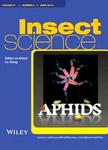Priming of antiherbivore defensive responses in plants
Priming of antiherbivore defensive responses in plants作者机构:Department of Entomology Pennsylvania State University University Park PA 16802 United States
出 版 物:《Insect Science》 (昆虫科学(英文版))
年 卷 期:2013年第20卷第3期
页 面:273-285页
核心收录:
学科分类:0710[理学-生物学] 0830[工学-环境科学与工程(可授工学、理学、农学学位)] 09[农学] 0906[农学-兽医学] 0904[农学-植物保护] 0901[农学-作物学] 090402[农学-农业昆虫与害虫防治] 0713[理学-生态学]
基 金:Support by the United States Department of Agriculture and Food Research Initiative program
主 题:defense priming epigenetic modifications plant-insect interactions
摘 要:Abstract Defense priming is defined as increased readiness of defense induction. A growing body of literature indicates that plants (or intact parts of a plant) are primed in anticipation of impending environmental stresses, both biotic and abiotic, and upon the following stimulus, induce defenses more quickly and strongly. For instance, some plants previously exposed to herbivore-inducible plant volatiles (HIPVs) from neighboring plants under herbivore attack show faster or stronger defense activation and enhanced insect resistance when challenged with secondary insect feeding. Research on priming of antiherbivore defense has been limited to the HIPV-mediated mechanism until recently, but significant advances were made in the past three years, including non-HIPV-mediated defense priming, epigenetic modifications as the molecular mechanism of priming, and others. It is timely to consider the advances in research on defense priming in the plant- insect interactions.



